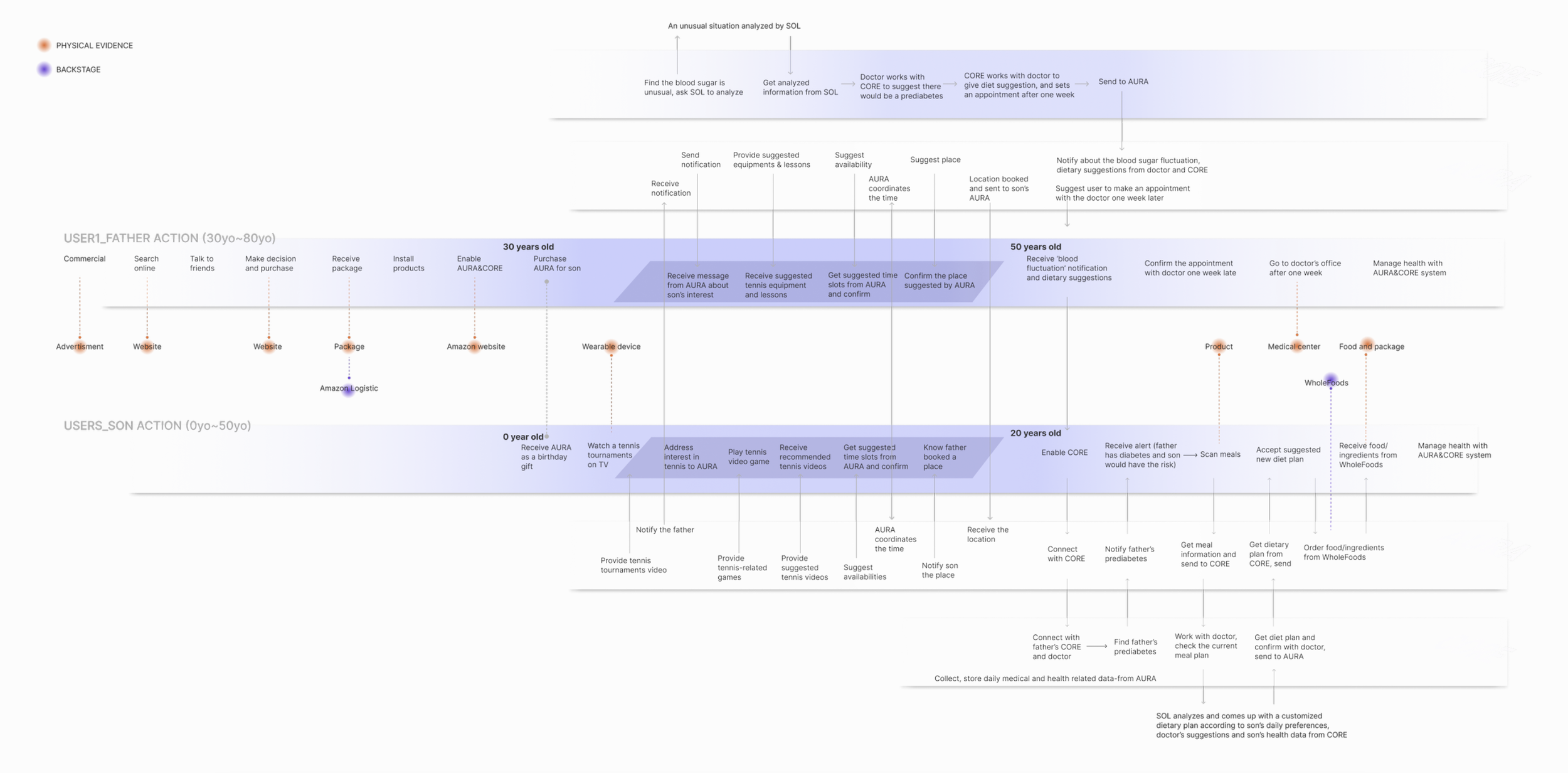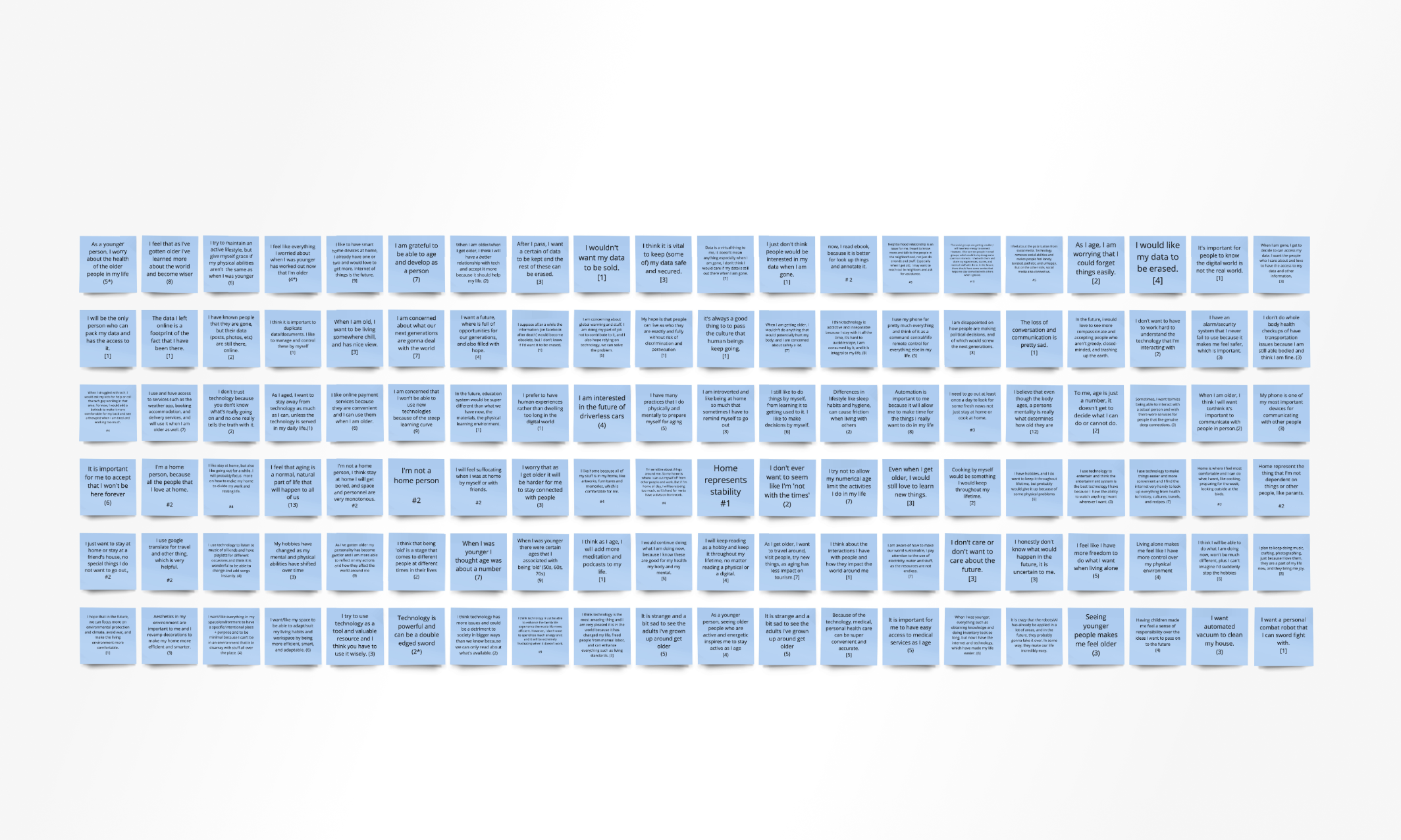Amazon
Internship
Provided an adaptive system that allows individuals to experience a better aging process

Duration -
January, 2023 - March, 2023
My Role -
Conducted workshops, and interviews, synthesized and analyzed data, and visualized the results with service blueprints, ecosystem maps, and stakeholder maps.
Project Brief -
Worked at Amazon Device Team to reevaluate how Amazon can best support customers as they age alongside technology. This project required extensive research, leading to the development of a proposal for a three-tiered system aimed at enhancing technological support for the aging population.
Result & Impact
Enhanced and ensured technological support for the aging population by proposing a three-tiered system to the Amazon Device team, improving accessibility and usability for this demographic.
Research
Research Approaches
Our research approaches varied, encompassing surveys and case studies. In the case studies, we examined various companies, including Google, Apple, Xiaomi, and Amazon, identifying 3 critical features tailored to meet the needs of the aging consumer.
Elder Tech - Using font and high-contrast displays, voice recognition, and touchscreen interfaces. It works by making technology more accessible and user-friendly for older adults, allowing them to stay connected with their loved ones, access information, and control their home environment.
Accessible Technology - Using technology to support older adults with disabilities or chronic conditions. Features of assistive technology include wearable devices, mobile apps, and home automation systems. It works by providing older adults with tools that can help them with activities of daily living, such as medication management, reminders, and fall detection.
Social Support - Using robots or other forms of artificial intelligence to suppo rt social interaction and communication with older adults. Features of social robotics include natural language processing, facial recognition, and emotional recognition. It works by providing older adults with a social companion that can respond to their needs and provide emotional support.
Comparative Analysis Diagrams
We synthesized and analyzed the data by visualizing it through ecosystem maps and comparative diagrams. [Click Image to Enlarge]
Amazon Ecosystem
Amazon's ecosystem maps comprehensively illustrate its array of products, services, devices, platforms, and systems. Positioned at the heart of Amazon's strategy is its 2C e-commerce business, with a strong focus on customer-centric approaches and scalability. Operating under a core business model of pan-B2C, Amazon consistently expands its reach across various geographies and extends its services to encompass all user scenarios, ensuring comprehensive coverage. [Click Image to Enlarge]
Affinitization
After spending the first few weeks conducting various interviews and surveys and after thoroughly researching ecosystem maps, case studies, and trends, we analyzed more than 800 data points to form.
Blew is a quick overview of our affinitization process.
Insights(Keywords)
What people wanted the technology to be: Integrated, Human-Centered, Freedom, Independent, Intuitive, and Accessible.
Archetypes
What we did differently - This time, we revisited our data, reviewing and organizing it differently by synthesizing it to align with the diverse needs of people. This approach streamlined the development of our archetypes in the subsequent stage.
Brainstorming
What did we want to build?
We aim to provide an adaptive system that allows individuals to be more independent and comfortable at home and experience a better aging process.
Initial Concept
We explored holistic workspaces, personalized AI Assistants, Developmental AI Assistants, tracking and sharing vitals, automated ordering and delivery, ubiquitous smart notifications, digital legacy, health and wellness mirror hubs, environmental control, and immersion adventures.
Through these explorations, we realized that aging is a complex and nuanced process that will look different for each one of us. This led us to exploring something that goes beyond just an independent product, and moving toward a larger adaptive system that could fit into a person’s life at any stage.
Aura (device name), as an extension of the whole system, operates as a separate entity, connecting to Alexa to individually serve each member of the family, which is a part of this numerous system.
Final Concept Propose
Technologies that we applied
Aura would use Radio-Frequency Identification or RFID, facial recognition, and voice recognition. RFID is a low cost, high security technology that does not require a network, and consists of a tag and a reader. A RFID tag associated with each aura would store information about each family member and act as a READER that would recognize different family members and react differently based on their stored personal data.
By looking into Erikson’s Stages of Development (theory), we could better integrate the system into the customer’s life/experience.
Sketches
With this concept, the base device or “hub” could utilize an existing Alexa and all future adaptations. In this configuration, Aura will be able to integrate with the basic modules of this system to collect information about them and their environment over time. The system could be integrated with future devices to extend their capabilities. Perhaps a tennis racket to measure swing and performance, a walking cane to measure walking cadence or any other combination of needs that a person could have.
A portable device that has a body with cameras, microphones, biometric sensors, and wireless capabilities that can adapt to many different form factors. It has a body that can be rotated and it can be connected to a head that can spin longitudinally for it. Through this head, it can achieve 360 degrees of rotation. It can be hung on a backpack, worn as an earring, a necklace, or an accessory. This personal device will allow the Aura system to accompany people wherever they go and change with them based on the scenario.
BluePrint
We visualized the entire system to have a clearer explanation of how each level of the internal system operates concurrently and collaborates with one another.


















